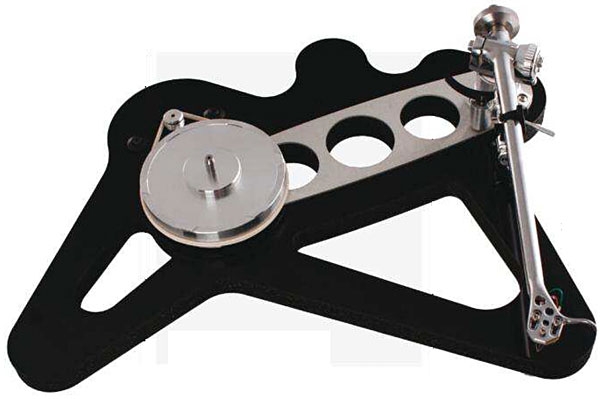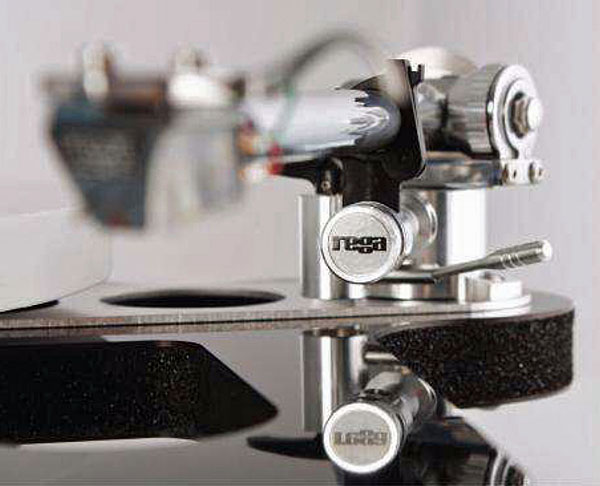| Columns Retired Columns & Blogs |
An incredible TT but I expected much better from such an esteemed brand... Back to dealer for full refund. Sadly, the dealer questioned my integrity...Life's just too short.

As the prices and levels of precision increase throughout the line, so does the attention Rega pays to build quality, manufacturing tolerances, and performance, including accuracy of platter speed. If you watch the videos I shot during my visit (footnote 2), you'll see the various stations at which each production unit is tested before it passes inspection and is packed for shipping. The attention Rega pays to every detail, including where it finds the round-cross-sectioned belts that drive their platters, should impress everyone, especially considering their turntables' reasonable prices—their current top model, the RP10, costs $5495, including an RB2000 tonearm.
The principles that have guided the design of Rega turntables have always been a rigid tonearm, a stiff plinth, and low overall mass—as Rega's cofounder, guiding spirit, and chief engineer, Roy Gandy, emphasized during my visit. Because modulations in a record's groove can be as small as one-millionth of a meter (one micron, 1µm), he believes that rigidity and mechanical stability trump the adjustability offered in some tonearms, which can come at the price of less precise playback, and thus with the result of reduced and/or less accurate reading of the information in the groove.
In the RP10, these long-held ideas have been realized to a greater degree than previously possible, thanks to Rega's ongoing research into new materials. The RP10's low-mass plinth prevents the transfer of energy from the more massive moving parts—the platter, bearing, and tonearm—to the plinth, where it can be stored and cause problems. If Rega could design a turntable with no plinth at all, I think they would. The goal is to get all of the groove energy to your speakers, not sink it in a massive plinth.
In the fifth and final video I shot during my visit, you can see these ideas taken to their ultimate implementation in Rega's Naiad, a prototype of a space-age turntable that includes an all-ceramic platter bearing that's difficult to make. When it at last goes into limited production, the Naiad will cost upward of $20,000; Rega has already taken orders for nearly 50 units. Until then, the RP10 remains their top model.
The RP10 shares with the less costly Rega RP8 ($2995) a skeletal, two-piece inner plinth and outer frame that takes to new extremes Rega's long commitment to a superstiff "skin" over a lightweight core. In the RP10 this is accomplished by using what Rega calls a "stressed skin structure": layers of hard phenolic resin sandwiching a core made of a custom formulation of Zotek, a featherweight, high-tech polyolefin foam of closed, nitrogen-expanded cells. According to Rega's Phil Freeman, they begin with a shoebox-sized block of Zotek saturated with nitrogen, which they then "shock-vacuum" in a compression chamber where it expands to a thin, rigid, symmetrical, closed-cell foam. The foam is then machined and the two layers of phenolic affixed, to produce a plinth seven times lighter than that of the original Rega Planar 3, while being far more rigid.
You either like the skeletal design or you don't. I love it, especially without the outer frame, to which the dustcover is attached. To me, the RP10 looks and sounds somewhat better minus the frame (which can be thought of as what's "left over" from cutting out the skeletal plinth) but it's easy enough to decide for yourself.
Don't be fooled by familiar-looking stuff
When I reviewed Technics' new direct-drive SL-1200G turntable and its limited edition, the SL-1200GAE, I felt I had to point out that while the new 'tables looked like the old SL-1200s, they were completely new from the ground up, including all-new tooling, a new magnesium tonearm, and, especially, a brand-new, coreless direct-drive motor.
While the RP10's plinth is the same as the RP8's, everything else has been substantially upgraded, and those upgrades include Rega's new RB2000 tonearm. It's not just a shinier version of the RB808 arm used on the RP8. Instead of the vertical bearing yoke of plastic found on less costly Rega arms, the RB2000's yoke is precisely machined from an aluminum alloy. Rega's tonearm assemblers first choose the closest-tolerance bearings for use in an RB2000, then precisely match them with the best-fitting horizontal spindle at the inside and outside diameters, so that this "interference fit" bearing assembly will produce the highest precision and so the least amount of chatter. This design minimizes the number of mechanical joints, while producing at the joints fits of close-enough tolerances to make adhesives unnecessary.

The armtube is Rega's latest, completely redesigned to redistribute mass and reduce resonances. It's polished by hand to an attractive, shiny, weight-reducing luster, and fitted with a high-mass tungsten counterweight to keep it as close as possible to the pivot point. This should improve dynamic performance, particularly when tracking warped records.
As I witnessed during my visit, assembling an RB2000 is time consuming. It requires a lot of training and skill, followed by precision testing to ensure a close-tolerance fit and a low-friction "ride." One of my videos shows the production of a lower-cost Rega arm; you'll see the difference, and understand why it costs far more to produce the RB2000.
Like the RP8 and many of the other less-expensive Rega 'tables, the RP10 includes Rega's system of fitting dual braces—both made from a phenolic resin with aluminum slin bracing—between the platter-bearing hub and the tonearm mount. Designed to increase system rigidity, this forms a structurally sound "stressed beam" designed to prevent the absorption of energy and distortion-producing resonances. Rega claims that, rather than using damping material, the different resonant frequencies of the magnesium and resin produce a canceling effect.
Unlike the RP8's glass platter, the RP10 has an improved version of the RP9's platter. It's made of a ceramic-oxide powder that's compressed, fired, and precision cut with a diamond to produce, Rega claims, "perfect surface accuracy and flatness." The shape of the platter's underside has been modified from the version in the RP9 to improve its coupling with the solid aluminum subplatter, which is driven by two white, circular-cross-section belts looped around its rim and a dual-ganged aluminum pulley atop the 24V AC motor. At Rega, some things never change: The RP10's platter is topped with a thin mat of wool, white instead of the usual black. The substantial subplatter and spindle-bearing assembly look identical to those in the RP8.
Finally, the motor's power supply has been substantially upgraded from those of previous Rega models. It's controlled by DSP, crystal-referenced, and is adjusted for the particular 24V motor with which it's partnered. The electronics include circuitry to smooth vibrations produced by the motor, as well as frequency control to achieve accurate platter speeds of 33 1/3 and 45rpm.
Footnote 2: I shot five videos of that visit. Start here

An incredible TT but I expected much better from such an esteemed brand... Back to dealer for full refund. Sadly, the dealer questioned my integrity...Life's just too short.